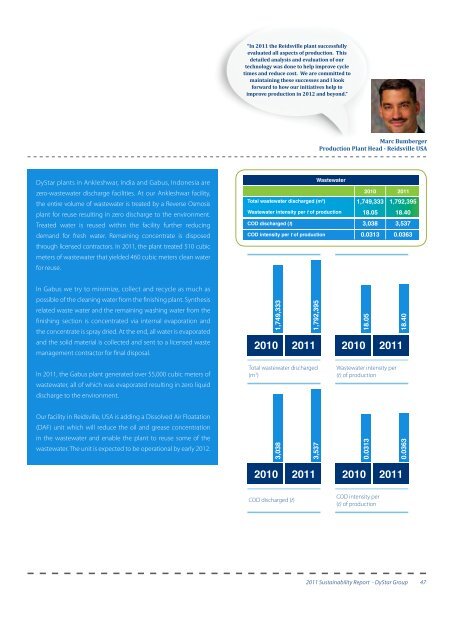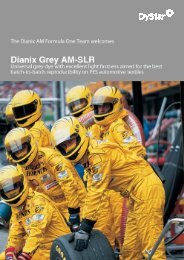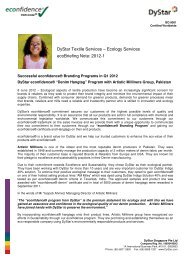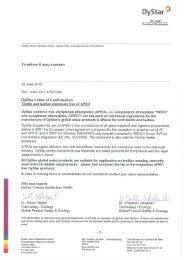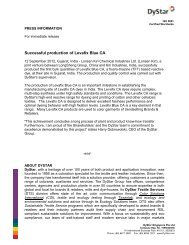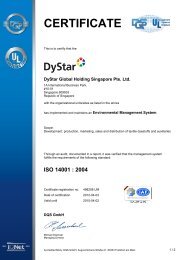Read the DyStar Sustainability Report 2011...
Read the DyStar Sustainability Report 2011...
Read the DyStar Sustainability Report 2011...
You also want an ePaper? Increase the reach of your titles
YUMPU automatically turns print PDFs into web optimized ePapers that Google loves.
<strong>DyStar</strong> plants in Ankleshwar, India and Gabus, Indonesia are<br />
zero-wastewater discharge facilities. At our Ankleshwar facility,<br />
<strong>the</strong> entire volume of wastewater is treated by a Reverse Osmosis<br />
plant for reuse resulting in zero discharge to <strong>the</strong> environment.<br />
Treated water is reused within <strong>the</strong> facility fur<strong>the</strong>r reducing<br />
demand for fresh water. Remaining concentrate is disposed<br />
through licensed contractors. In 2011, <strong>the</strong> plant treated 510 cubic<br />
meters of wastewater that yielded 460 cubic meters clean water<br />
for reuse.<br />
In Gabus we try to minimize, collect and recycle as much as<br />
possible of <strong>the</strong> cleaning water from <strong>the</strong> finishing plant. Syn<strong>the</strong>sis<br />
related waste water and <strong>the</strong> remaining washing water from <strong>the</strong><br />
finishing section is concentrated via internal evaporation and<br />
<strong>the</strong> concentrate is spray dried. At <strong>the</strong> end, all water is evaporated<br />
and <strong>the</strong> solid material is collected and sent to a licensed waste<br />
management contractor for final disposal.<br />
In 2011, <strong>the</strong> Gabus plant generated over 55,000 cubic meters of<br />
wastewater, all of which was evaporated resulting in zero liquid<br />
discharge to <strong>the</strong> environment.<br />
Our facility in Reidsville, USA is adding a Dissolved Air Floatation<br />
(DAF) unit which will reduce <strong>the</strong> oil and grease concentration<br />
in <strong>the</strong> wastewater and enable <strong>the</strong> plant to reuse some of <strong>the</strong><br />
wastewater. The unit is expected to be operational by early 2012.<br />
“In 2011 <strong>the</strong> Reidsville plant successfully<br />
evaluated all aspects of production. This<br />
detailed analysis and evaluation of our<br />
technology was done to help improve cycle<br />
times and reduce cost. We are committed to<br />
maintaining <strong>the</strong>se successes and I look<br />
forward to how our initiatives help to<br />
improve production in 2012 and beyond.”<br />
Total wastewater discharged (m 3 )<br />
Wastewater<br />
Wastewater intensity per t of production<br />
COD discharged (t)<br />
COD intensity per t of production<br />
1,749,333<br />
2010<br />
Total wastewater discharged<br />
(m 3 )<br />
3,038<br />
COD discharged (t)<br />
1,792,395<br />
2011<br />
3,537<br />
Marc Bumberger<br />
Production Plant Head - Reidsville USA<br />
2010<br />
2010 2011<br />
1,749,333 1,792,395<br />
18.05 18.40<br />
3,038 3,537<br />
0.0313 0.0363<br />
18.05<br />
Wastewater intensity per<br />
(t) of production<br />
0.0313<br />
2010 2011 2010 2011<br />
COD intensity per<br />
(t) of production<br />
18.40<br />
2011<br />
0.0363<br />
2011 <strong>Sustainability</strong> <strong>Report</strong> - <strong>DyStar</strong> Group 47


